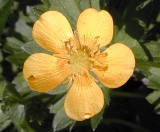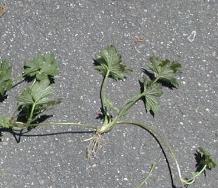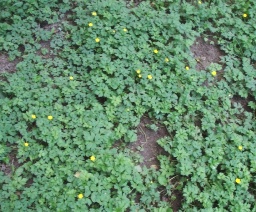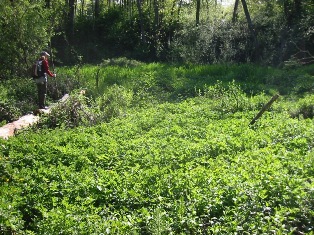 Creeping buttercup
Creeping buttercup
(Ranunculus repens)
Creeping
buttercup is a perennial species of buttercup native to Europe; now found across North America and throughout much of the world. Creeping buttercup loves moist soils and is invasive.Identification
> perennial> height up to 1', generally shorter
> leaves dark green with light patches, divided into three toothed leaflets
> central leaflet on the plant stalk
 > flowers generally have 5 (sometimes doubled to 10) bright yellow (glossy) petals and grow singly on long grooved stalks
> flowers generally have 5 (sometimes doubled to 10) bright yellow (glossy) petals and grow singly on long grooved stalks> flowers generally bloom March to August/September
> "fruits" are firm clusters of 20-50 achenes on round-prickly heads, each producing 20-150 seeds, dispersed by wind, water, and animals
> seeds can last up to 80 years in waterlogged soils
> creeping stolons (runners) with short swollen stems, can root at stolon nodes
Impacts
Creeping buttercup is very invasive and competitive, crowding out other plants, especially in moist soils. A single plant can spread over 40' square per year. Creeping buttercup generally has a negative impact on other plants and is toxic (can be fatal) to animals. It also depletes soils of potassium.
 Habits
Habits
Creeping buttercup responds to immediate environmental conditions, spreading via seeds and/or stolons depending upon which is most most favorable in the conditions. The structure of the stolons even responds to the environment: number, length, numbers of branchings, etc.Creeping buttercup can overwinter as a rosette or die back to ground level, storing nutrients in short swollen stems that growth rapidly the next spring.
Prevention/Control/Eradication
In the case of Creeping Buttercup, slow and steady wins the race. Protect other species while working on control the buttercup, moving from less to more heavily infested areas. Creeping buttercup will also grow in moist sandy and gravel-based soils and will tolerate salinity. In woodlands, this buttercup is mainly restricted to clearings, forest margins and paths. It is frost tolerant and will survive moderate droughts. Creeping buttercup is a very tolerant plant: frosts, moderate droughts, shade (forest margins, paths and clearings), soil compaction (trampling and grazing).> promote healthy grass by over-seeding, fertilizing as needed, and not over-grazing;
> add lime to improve grass health and keep buttercup from re-establishing (lime won’t control buttercup that is already well established);
> improve soil drainage and reduce compaction by aerating and avoid trampling when soils are wet;
> clean mowers and other equipment to avoid spreading buttercup seeds;
> remove all of the runners, roots and growing points by trowel (this is most effective from fall to spring while the soil is moist and roots break off less);
> incomplete removal of roots and stems may increase the buttercup population (they can sprout from nodes along stem and root fragments);
> soil can increase seed germination (the number of seeds in infested soils can be immense compared to the number of plants present);
> creeping buttercup’s growing point is at soil level, so plants resist mowing and quickly re-sprout when cut;
> regular cultivation can kill the buttercup but plants buried by cultivation can grow back up through deep soil and re-establish themselves and long-lived seeds in the soil can germinate and re-infest the area once cultivation ceases;
> herbicides can be used if allowed and appropriate for the site and land use (use great care to follow all label directions to ensure safe and effective use).
> usually requires at least two or three applications to eradicate creeping buttercup because of the seed bank and because some mature plants will generally recover;
> carefully monitor the treated area for re-growth and pull up any new seedlings before they establish runners.










